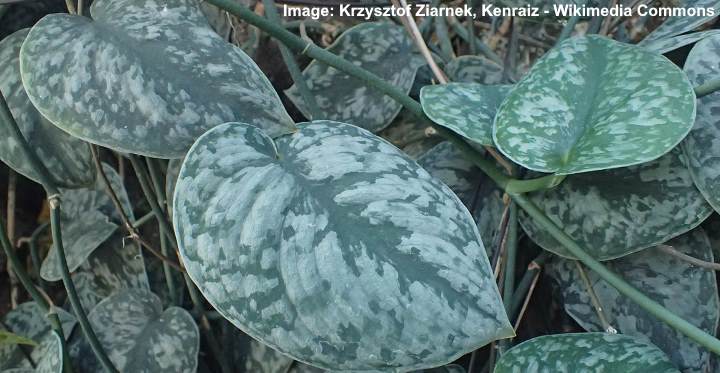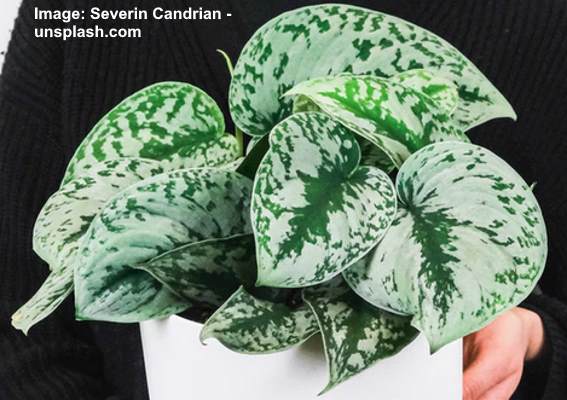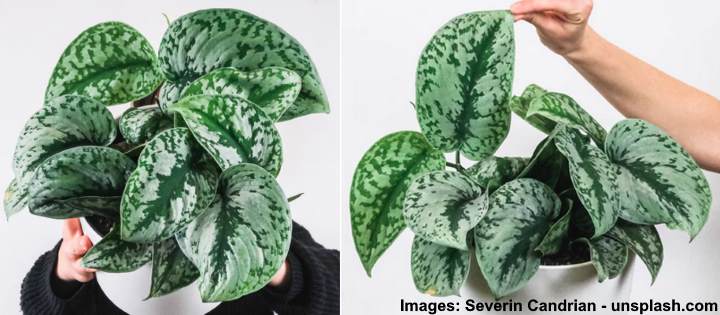Scindapsus Pictus ‘Exotica’: Plant Care and Growing Guide (Pictures)

Scindapsus Pictus ‘Exotica’ is a striking vining plant with large, heart-shaped dark-green leaves with silvery-white splashes. The long trailing stems of the Scindapsus Pictus ‘Exotica’ with its velvety green and silver leaves bring the tropics to your living space. This tropical hanging basket plant goes by the common names Satin Pothos, Silver Pothos, Philodendron Silver, and Silver Vine. The slow-growing Scindapsus ‘Exotica’ climber is one of the easiest houseplants to grow.
There are many ways to grow a Scindapsus Pictus ‘Exotica’ indoors. You can grow it as a bushy tropical plant in pots, climbing up a moss pole, or gracing a hanging basket.
This article is a growing guide for the Scindapsus Pictus ‘Exotica’ houseplant. At the end of the article, you’ll find out how to resolve common issues when growing a Satin Pothos indoors.
How to Care for Scindapsus pictus ‘Exotica’
To care for Scindapsus Pictus ‘Exotica’ plant, grow the vining large-leafed plant in indirect bright light and a loose, well-drained potting mix. Water the Scindapsus ‘Exotica’ whenever the soil partially dries. Keep temperatures between 65 and 85°F (18 – 29°C) and humidity at least 50 percent. Fertilize every four weeks during the growing season.
What is Scindapsus pictus ‘Exotica’?

Scindapsus pictus ‘Exotica’ is a tropical vining plant with gray and green variegated leaves
Scindapsus pictus ‘Exotica’ is a flowering evergreen climbing plant belonging to the family Araceae. The tropical, twining plant grows outdoors in USDA zones 10 through 12. Its native habitat is the humid, tropical regions of Asia, where it grows as a creeping plant on the ground in the shade or climbing up trees.
In the wild, Scindapsus pictus ‘Exotica’ is a relatively slow-growing plant. Its creeping vines reach up to 10 ft. (3 m) tall. The tropical plant also produces small flowers in its native environment.
Growing indoors, Scindapsus pictus ‘Exotica’ vines grow up to 3 ft. (1 m) long. The dark green leaves with the silvery blotches look stunning on cascading vines dangling from hanging baskets. It’s rare for Scindapsus pictus ‘Exotica’ to flower indoors.
Although Scindapsus pictus ‘Exotica’ has common names such as Satin Pothos, Silver Pothos, or Philodendron Silver, the plant doesn’t belong to either species. Its botanical name— Scindapsus pictus—refers to the silver “painted” effect on the gray-green variegated leaves.
Scindapsus pictus ‘Exotica’ Leaves
The large, eye-catching heart-shaped (cordate) leaves of Scindapsus pictus ‘Exotica’ make this a sought-after houseplant. The leafy tropical foliage has a velvety feel. The large oval, pointed leaves grow densely on the trailing vines, giving the Scindapsus ‘Exotica’ plant a lush, tropical look.
The silvery markings on the variegated cordate leaves look like splashes of paint. Compared to Scandapsus pictus ‘Argyraeus,’ the silver blotches cover most of the leaf. About 60 to 90 percent of the ‘Exotica’ plant’s leaf surface is covered in silvery speckles.
Scindapsus pictus ‘Exotica’ Care Guide
Let’s look in more detail at the best way to grow a Scindapsus pictus ‘Exotica’ at home
Where to Grow Scindapsus pictus ‘Exotica’
Scindapsus pictus ‘Exotica’ is an appropriate name because it’s a stunning exotic houseplant. The trailing leafy vines grow well in a bright location. Ideally, you can grow the Satin Pothos in a hanging basket near a sunny window. Or the dangling 3-foot (1-m) vines look stunning hanging from a high shelf or bookcase.
You can grow a bushy Scindapsus pictus ‘Exotica’ to grace a table or desk with the proper pruning. Because the exotic plant tolerates some shade, it’s ideal for growing in a bedroom, office, or north-facing room. The pothos-like plant especially thrives in a bathroom where the extra humidity helps the plant grow faster.
Scindapsus pictus ‘Exotica’ Light Requirements

Scindapsus pictus ‘Exotica’ grows well in an indirect light
Scindapsus pictus ‘Exotica’ thrives in a sunny location, as long as it’s protected from direct sunlight. Bright light is necessary to help keep the vibrant silver and green variegation on the heart-shaped silky leaves. However, the sun’s intense rays can scorch or bleach the leaves if it’s in full sun for too long.
Scindapsus ‘Exotica’ is a shade-tolerant plant. But it’s good to remember that too much shade can cause the stunning variegation to fade. If you notice that the silver blotches are less pronounced, move the ‘Exotica’ plant to a brighter place. The extra light should help revive the variegation and restore the beautiful foliage colors.
The Best Soil for Growing Scindapsus pictus ‘Exotica’
Grow Scindapsus pictus ‘Exotica’ in fertile, well-draining soil. To make a homemade potting mix for pothos plants, combine three parts peat moss, one part shredded bark, and one part perlite. Alternatively, you can buy a commercial potting mix for succulents and amend it with gravel or perlite for drainage.
The best potting soil for Scindapsus pictus ‘Exotica’ should retain moisture in the root area without being too soggy. To achieve this, peat moss is an excellent soilless medium because it’s light and airy yet retains moisture. Soil amendments such as perlite, gravel, pumice, and charcoal help oxygenate the soil and let the excess water drain faster.
How to Water Scindapsus pictus ‘Exotica’ Houseplants
Water Scindapsus pictus ‘Exotica’ only when the top 2” (5 cm) of soil is dry. In summer, you may need to water the pothos plant once or twice a week. In winter, you can cut back watering to once a fortnight or so. The soil should never become too damp, or you risk root rot.
The best way to water Scindapsus pictus ‘Exotica’ is to soak the soil thoroughly with filtered water at room temperature. Allow the excess water to drain out before putting the pothos pot back on the drip tray. To tell when you should water the Scindapsus pictus plant again, ensure the top layer of soil is dry.
Scindapsus pictus ‘Exotica’ is on the list of low-maintenance houseplants, so you don’t need to water it too often.
One of the worst things you can do to a hanging basket pothos plant is overwater it. Overly-damp soil causes roots to decay. When root rot occurs, the lush, tropical foliage is starved of nutrients. The result is mushy stems, weak growth, and yellow leaves.
In the worst-case scenario, the Scindapsus ‘Exotica’ will die. If root rot is extensive, take healthy cuttings from the plant and propagate them.
Scindapsus ‘Exotica’ Temperature Guide
Scindapsus pictus ‘Exotica’ thrives in temperatures between 65 and 85°F (18 – 29°C). So, average room temperatures are perfect for growing a Satin Pothos indoors. Ensure that the temperature doesn’t drop below 60°F (16°C); otherwise, the plant’s foliage can suffer. Additionally, Scandapsus ‘Exotica’ plants prefer an even temperature.
Sometimes, household heating and cooling may cause stress for Scindapsus pictus ‘Exotica’ plants. For example, drafty windows or air-conditioning airflow can affect the plant’s growth. Or during the winter, household heating can affect the foliage if the plant is too close to a heat vent or the air is too dry.
You can grow Scindapsus pictus ‘Exotica’ outside in USDA zones 11 and 12, and possibly 10. In temperate climates, the hanging basket pothos can add greenery to a patio or balcony during the summer. But you’ll need to take the plant indoors if the temperature dips lower than 60°F (16°C).
Scindapsus ‘Exotica’ Humidity Requirements
Scindapsus pictus ‘Exotica’ has medium humidity needs when growing indoors. Ideally, relative humidity should be around 40 or 50 percent. However, the plant will grow better in higher humidity. You may need to boost air moisture levels if you notice browning on the tips.
Despite coming from the tropics, Scindapsus pictus ‘Exotica’ adapts well to drier, indoor air. However, you’ll need to ensure the plant gets good air circulation and that it never gets too dry.
Should you mist Scindapsus pictus ‘Exotica’ plants? Misting may provide some moisture to the leaves. However, it isn’t the best solution to keep tropical plants humid. Better ways of increasing humidity include putting the pot on a pebble and water tray, grouping houseplants together, or buying a room humidifier.
Scindapsus pictus ‘Exotica’ Growth Rate
Scindapsus ‘Exotica’ vines typically have a slow growth rate. Over a few years, the long, leafy stems eventually reach about 3 ft. (1 m) long. Ensuring that growing conditions are ideal speeds up growth. This means keeping the ‘Exotica’ plant in warm, humid conditions and only watering when necessary.
How to Fertilize Scindapsus pictus ‘Exotica’
Fertilize Scindapsus pictus ‘Exotica’ once a month during spring and summer. The large-leaf vining plant benefits from a diluted, balanced houseplant fertilizer. Regular fertilizing helps ensure the soft dark-green and silver foliage grows fast and remains vibrant.
To fertilize Scindapsus pictus ‘Exotica,’ apply diluted fertilizer every four weeks after watering. Every three or four months, it’s a good idea to flush the soil to prevent a buildup of mineral salts. This prevents root burn that can cause leaves to turn brown and unsightly.
Scindapsus pictus ‘Exotica’ growth becomes almost dormant in late fall and winter. Therefore, you should stop fertilizing during those months. Also, you’ll only need to water the plant’s soil just enough to prevent it from drying out completely.
How to Prune Scindapsus pictus ‘Exotica’ Plant
Prune Scindapsus pictus ‘Exotica’ vines by trimming the long stems to the required length. Cutting just below a node encourages new growth and is an excellent way to grow a bushy ‘Exotica’ plant.
To improve a satin pothos plant’s appearance, it’s a good idea to prune leggy stems that have few leaves growing. You should also trim off yellow leaves and any dead or dying stems to improve the plant’s appearance and health,
Pruning the twining Scindapsus pictus vines is also the best way to propagate a new plant.
How to Propagate Scindapsus pictus ‘Exotica’
Stem cuttings are the best way to propagate Scindapsus pictus ‘Exotica.’ For best propagation results, snip off one or more healthy stems that are 5” to 6” (12 – 15 cm) long. Cut the stems just below the node and make sure there are at least three nodes and a few leaves on the vine.
To root the stem cutting, remove the lower leaves and place the vines in a jar of water. Wait for two to three weeks for new roots to appear from the submerged node. Transfer the rooted pothos cutting to a pot that has fresh potting soil, water well, and put in indirect bright light.
Another propagation method involves putting the Scindapsus pictus stem cutting directly in the soil. If you use this technique, keep the pot sealed in a plastic bag. Mist the soil every so often to keep it moist. This way, you create a humid environment to speed up rooting. After three or four weeks, you can remove the covering and grow the pothos normally.
Repotting Scindapsus pictus ‘Exotica’ Plant
It’s a good idea to repot Scindapsus ‘Exotica’ every two years. Transferring the vining tropical plant to a larger pot encourages more growth and allows you to refresh the potting soil. During the repotting process, you can check the roots for signs of decay or damage.
Signs that it’s time to repot a Scindapsus pictus ‘Exotica’ include roots growing out from the pot, slow growth, and water pooling on the soil’s surface.
It’s simple to repot a tropical Scindapsus pictus ‘Exotica.’ Remove the plant from its current pot. Remove excess dirt from the roots. Check for any roots showing signs of decay and remove them as necessary. Fill a new, slightly larger pot with the appropriate soil, and replant the pothos houseplant.
Top Scindapsus ‘Exotica’ care tip: Don’t choose a container that is too large as this can create drainage issues, cause soil to stay soggy, and lead to root rot.
Is Scindapsus pictus ‘Exotica’ Houseplant Toxic?
Scindapsus pictus ‘Exotica’ is poisonous to dogs, cats, and other animals. According to the ASCPA, plants in the Scindapsus pictus species contain insoluble calcium oxalates. This toxic substance can result in severe irritation, causing excessive drooling, oral swelling, and difficulty swallowing.
The sap from Satin Pothos plants can also cause skin itching, dermatitis, and burning on human skin.
Pests Affecting Scindapsus pictus ‘Exotica’ Growth
Scindapsus pictus ‘Exotica’ is a relatively hardy plant, and pests rarely affect its growth. Typically, scale insects and spider mites are the two main insects affecting the plant’s growth. Spotting the common signs of houseplant pests early on is the best way to get rid of pests.
Spider mites are identified by thin, strand-like webs dangling from Scindapsus ‘Exotica’ plant foliage. Scales look like brown, bumpy growths on stems.
What are the best methods to eradicate pests from Satin Pothos plants?
Here is how to make a bug spray to get rid of pests on a Satin Pothos: Mix 2 tsp. neem oil and 1 tsp. liquid dish soap with 1 quart (1 l) of water. Combine the ingredients in a spray bottle. Liberally spray the natural neem oil pesticide on the plant’s foliage and leave it to dry. Repeat every seven days for best results.
Diseases Affecting Scindapsus pictus ‘Exotica’ Growth
The most common diseases affecting Scindapsus pictus ‘Exotica’ relate to overwatering. Root rot occurs when the tropical plant’s roots get waterlogged. Soggy soil causes fungal infections that start to destroy the root system. In time, the stems can become black and mushy, and the leaves will turn yellow.
To prevent Scindapsus pictus ‘Exotica’ suffering from root rot, always water the plant when the soil partially dries. This way, you prevent the soil from becoming overly moist for too long.
What should you do if you spot signs of root rot? It’s usually best to repot the Scindapsus pictus ‘Exotica’ in fresh potting soil. Prune any roots that show signs of decay. However, if most of the roots are rotten, it’s best to take cuttings from healthy vines and propagate new pothos plants.
Caring for Scindapsus pictus ‘Exotica’ — FAQs
Scindapsus pictus ‘Exotica’ is a low-maintenance vining houseplant. If you keep the hanging basket plant in a bright place and water it correctly, the tropical houseplant should give you few problems. But sometimes, you may notice that the ‘Exotica’ plant seems stressed.
Here are some common problems affecting the varieties of Satin Pothos.
How can I make Scindapsus pictus ‘Exotica’ plants grow faster?
Scindapsus pictus ‘Exotica’ growth is fastest when it grows in ideal indoor conditions. This means giving the plant plenty of indirect sunlight, watering it appropriately, and keeping it away from temperature extremes. The Scindapsus ‘Exotica’ plant will grow up to 3 ft. (1 m) tall.
Why are Scindapsus ‘Exotica’ plant leaves turning brown?
Low humidity levels typically cause Scindapsus pictus ‘Exotica’ leaf tips to turn brown. So, try increasing humidity by placing the pot on a pebble and water tray. Or the brown leaves could be caused by the tropical houseplant being in too much direct sunlight.
Why are Scindapsus pictus ‘Exotica’ leaves turning yellow?
Yellow leaves on a Scindapsus pictus ‘Exotica’ are usually an indicator of overwatering. Soggy soil causes the roots to become waterlogged, meaning they can’t absorb nutrients. The result is that leaves get starved, and they become pale and yellow.
Why are my Scindapsus pictus leaves curling?
Several reasons can cause the velvety heart-shaped green and silver pothos leaves to curl. The curled foliage could be due to too much dry heat, underwatering, or not enough sunlight. Try to ensure the tropical plants gets enough humidity, water it occasionally, and place the pot in adequate sunlight.
How do I bring my silver pothos (Scindapsus pictus ‘Exotica’) back to life?
To revive a dying Scindapsus ‘Exotica,’ it’s essential to identify the underlying reason for poor growth. The most common reason for a Silver Pothos dying is root rot. Check the soil for dampness and repot the plant in fresh soil. Other reasons your pothos is suffering could be underwatering, too much direct sunlight, or a lack of humidity.
Related articles:
